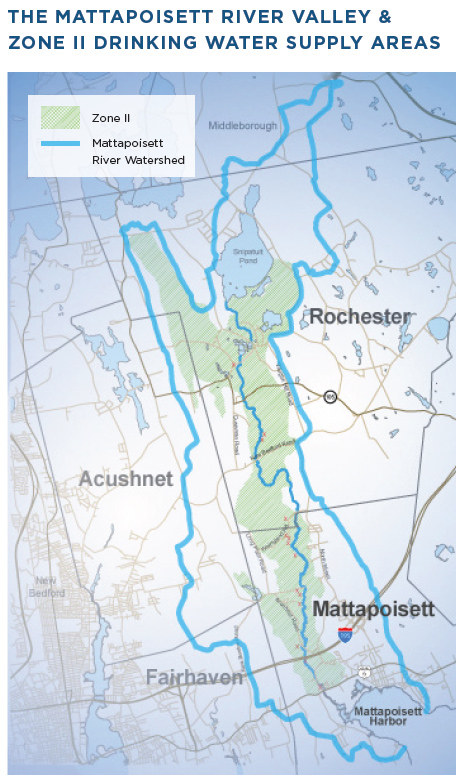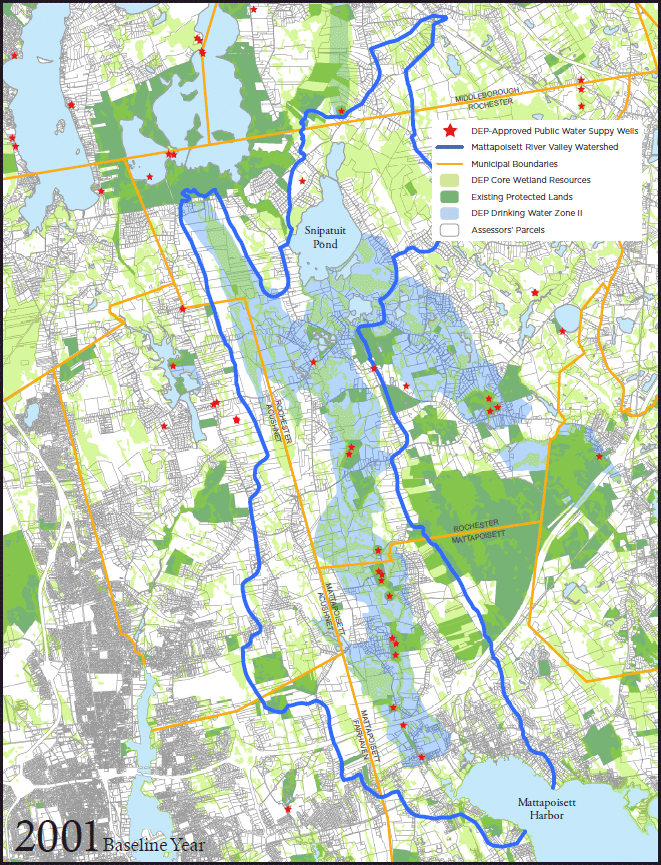Nearly 1,500 acres of land protected in Mattapoisett River Valley in past 15 years
In 2000, land conservation in the Mattapoisett River Valley was weak. Even though thousands of local residents in Fairhaven, Mattapoisett, Marion, and Rochester get their drinking water from underground aquifers in this river valley, only 8% of the land was permanently protected from development.
Over the past 15 years, the Coalition has worked in close partnership with these towns to forever protect 1,468 acres of forests and wetlands in the Mattapoisett River Valley – a rate of nearly 100 acres per year. These results are outlined in a new report the Coalition issued about the partnership’s progress to conserve land and protect drinking water in the river valley.

The most critical portion of land to protect in the Mattapoisett River valley is known as “Zone II.” This is the area closest to the wells from which the towns of Fairhaven, Mattapoisett, Marion, and Rochester draw public drinking water.
The Mattapoisett River Valley spans from Snipatuit Pond in Rochester to Mattapoisett Harbor, where the river meets the waters of Buzzards Bay. The area is a destination for people to go hiking, fishing, paddling, hunting, wildlife watching, and exploring. The river itself supports a historically active herring run, and a number of rare and threatened plants and animals call the river valley home.
But the river valley is just as important for what you can’t see: the underground aquifer that supplies drinking water to more than 24,000 local residents. Fairhaven and Mattapoisett get all of their public drinking water from a series of wells within the river valley. In addition, Marion gets 60% of its drinking water from these wells, and Rochester residents draw from the aquifer as well. The river valley is a clean, dependable source of public drinking water – yet 17 years ago, the land in this area wasn’t properly protected from development.
Conserving land is one of the most important ways to protect clean water for drinking, swimming, and fishing. Everything we do on the land affects the health of our rivers, harbors, and Buzzards Bay. Natural areas like forests, streams, and wetlands work together to shield the Bay from harmful pollution. When we conserve land, we are saving the essential parts of the Bay ecosystem so it remains healthy for generations to come.
The most critical portion of the Mattapoisett River Valley is the 6,000 acres of land closest to the drinking water wells. This area is designated as “Zone II” by the Massachusetts Department of Environmental Protection. Protecting land in Zone II is one of the best and most cost-effective ways to preserve clean drinking water for local residents.
Through the Mattapoisett River Valley Water Supply Protection Advisory Committee, the towns of Fairhaven, Mattapoisett, Marion, and Rochester joined forces with the Coalition in 2000 to strategize how to accelerate the pace of land conservation in the river valley. Despite that fact that so little land in the river valley was protected, there were many strong conservation opportunities. Much of the remaining undeveloped land in this area exists in large parcels that have been passed down by local families with solid land ethics and community ties.
In the following 15 years, between 2001 and 2016, the partnership worked together to protect 1,468 acres of forests and wetlands – a rate of 98 acres per year. The maps below show where these lands are located within the river valley.

Through 27 separate real estate transactions, the Buzzards Bay Coalition and the towns of Fairhaven, Mattapoisett, Marion, and Rochester permanently protected nearly 1,500 acres of land in the Mattapoisett River valley between 2001 and 2016.
Today, 17% of the Mattapoisett River Valley is forever protected from development, up from 8% in 2001. The stats are even better in the critical Zone II area that surrounds the towns’ drinking water wells: 28% of this land is now permanently protected. Some of this land is now open to the public, such as the trails at The Bogs and Tripps Mill at the Coalition’s Mattapoisett River Reserve. Other areas are protected with conservation restrictions, which keep the land in private ownership. Areas closest to the drinking water wells are now owned by the town water departments.
Even though we’ve achieved outstanding success conserving land in the river valley over the past 15 years, our work is not nearly complete. For instance, 72% of Zone II is still unprotected from uses that might pollute the water supply. The Coalition will continue to partner with these towns to conserve more land in the Mattapoisett River Valley to protect clean drinking water for local residents.
In April, the Coalition will open trails at two newly protected properties at Tinkhamtown Woodlands in Mattapoisett and New Boston Road in Fairhaven, growing the popular Mattapoisett River Reserve to over 500 acres of publicly accessible forests, wetlands, and cranberry bogs for hiking, paddling, fishing, hunting, and wildlife watching.